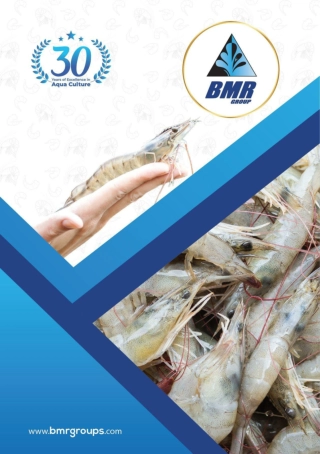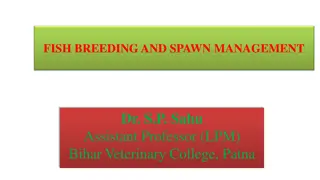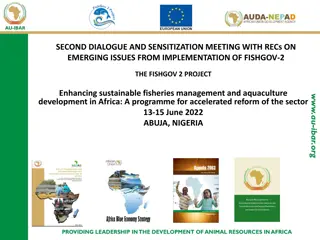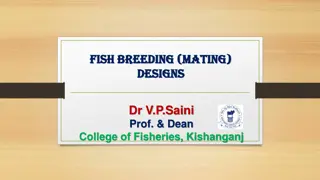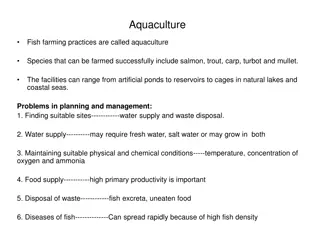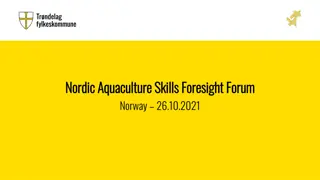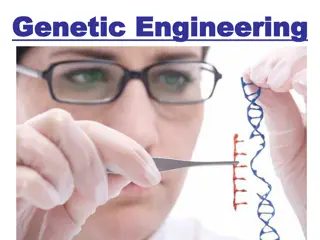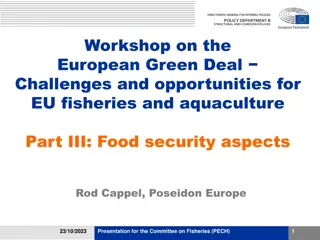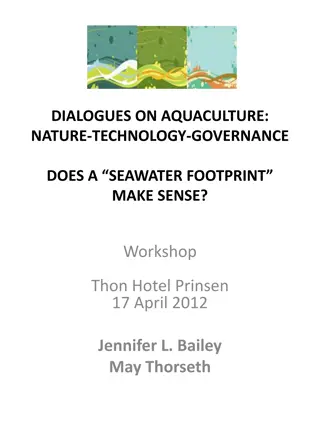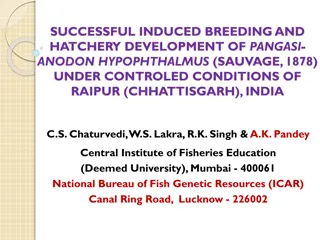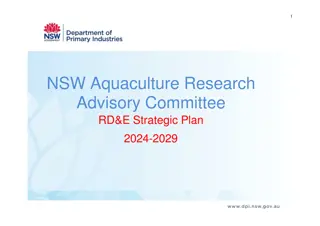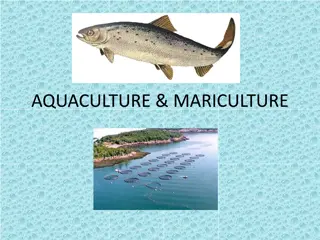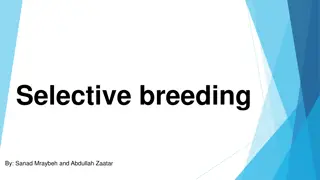Artificial Breeding Processes in Aquaculture Management
Efficient methods in artificial breeding processes for aquaculture management include broodstock selection, management techniques in tropical climates, and anaesthetic processes. Maintaining optimal conditions, proper handling, and careful selection are crucial for successful breeding and spawning operations.
Download Presentation

Please find below an Image/Link to download the presentation.
The content on the website is provided AS IS for your information and personal use only. It may not be sold, licensed, or shared on other websites without obtaining consent from the author.If you encounter any issues during the download, it is possible that the publisher has removed the file from their server.
You are allowed to download the files provided on this website for personal or commercial use, subject to the condition that they are used lawfully. All files are the property of their respective owners.
The content on the website is provided AS IS for your information and personal use only. It may not be sold, licensed, or shared on other websites without obtaining consent from the author.
E N D
Presentation Transcript
Broodstock management in tropical climates Two sets of ponds are used for the ripening males and females, and two sets of ponds are used for the spent spawners. This prevent wild spawning
In the broodstock ponds, it is advisable to include some smaller (100-200 g) carnivorous fish with the carp breeders About 200-400 ind/ha is sufficient to control the wild fish which might enter the pond and compete for food with the broodstock.
The breeders which are to be propagated artificially on a particular day, are taken from the storage ponds the day before. They are crowded into a corner of the half-drained pond with a seine net Skilled worker selects the breeders one by one 1- mature breeders are brought into the hatchery building 2- immature breeders are put back into the storage pond 3- unhealthy or invalid fish are sent to the market
It is important to avoid dissolved oxygen deficiency which may damage the sensitive breeders during seining and selection It is best to handle carp breeders using a special net with a strong mesh
Brooders Selection 1- the selected fish should be in good health 2- with no body wounds 3- with no parasites 4- with typical scale distribution 5&6- no fin or body deformation 7&8- The body should possess the required shape and proportions, being neither too fat, nor too thin.
Brooders Selection Male and female breeders may be easily differentiated by the shape of the body and the relative position of the genital papilla. In females, the body is plump and the genital opening is situated above the genital papilla In males, the body is slender and the genital opening is found behind the genital papilla.
Anaesthetic Process Three chemicals may be used as fish anaesthetics 1- MS 222 or tricaine methane-sulphonate is a very mild and safeanaesthetic from which fish easily recover. Fish may be kept in it for about 30 minutes at 20-25 C. it is rather expensive and must be used sparingly MS 222 1:10000 or 10 g dissolved in 100 L. water
2- Quinaldine or 2-4 methylquinolin is a toxic chemical which should be handled with great care and stored safely. During the treatment of the fish, they should be carefully watched and transferred quickly to well oxygenated water if necessary Quinaldine 1:40000 or 2.5 ml dissolved in 100 L. water 3- Phenoxyethanolis milder and less effective than MS 222 but is far cheaper Phenoxyethanol 1: 5 000 or 200 ml dissolved in 100 L. water
When the selected female breeders are brought into the hatchery early in the morning, they are placed in a small tank containing 100 litters of water They are anaesthetized, using for example MS 222, From now on the anaesthetized breeders should be watched carefully to see if their opercules keep moving. The life of the fish is in danger when this movement stops. In this event the breeder should be immediately removed from the anaesthetic solution and put into well-aerated fresh water
The advanced technique of the artificial propagation of common carp involves a hormonal treatment prior to hand stripping of the mature spawners to obtain sperm and eggs Females (First injection: 0.3 mg/kg, Second injection: 3.5 mg/kg) Males (one injection only: 2.0 mg/kg(
Injections of gonadotropin hormones induce the final ripening of the dormant eggs in the selected females The gonadotropin hormones to be injected in the breeders are extracted from dried hypophyses
(A) For mirror carps, the injection is intramuscular. It is generally given in the Muscles below the tip of the dorsal fin, at a 45' angle. To avoid losing some of the injected solution, a finger should be kept on the punctured skin which should be slowly massaged (B) For scaly carps, the injection is intraperitoneal. It is generally given into the body cavity from behind the base of the abdominal fin
After being injected, the females are placed in a large tank A plentiful supply of well-aerated water should be provided. The water temperature should be kept constant, if possible Within the optimum spawning temperature range of 22 C-24 C. To reduce stress, the females should be kept in a quiet environment and left undisturbed for 10-12 hours
Afte10-12-hour the females are anaesthetized for the suture of their genital opening and for the second injection of gonadotropins
The injected females are put back into the large tank, supplied with warm and well-aerated water The length of the ovulation period is closely related to the water temperature
When the females are fully ripe, they are crowded into one end of the tank with a sliding net frame.T hey can then easily be removed individually, for anaesthetizing and stripping


